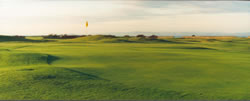
Philosophy
A preference for the natural, traditional look has always guided the working hand of Donald Steel. Classical golf values underpin his faith. Golf course architecture obeys no rules. Architects have a free hand. Courses come in all shapes and sizes, bound neither by dimensional restrictions nor standardised fashion. Good architecture relies on the virtues that cannot be taught - intuitive thought, imagination, an eye for land and a knowledge of the game.
However, there are a few rules of thumb that most accept as the fount of inspiration. They form the gospel of links golf that extols the virtues of improvisation, invention and ingenuity in shot making. It also believes that the golf course should be part of its surroundings, blending as imperceptibly as possible with the landscape. Only as a last resort should the landscape be transformed to accommodate the golf course. Good courses protect the environment, bad designs disfigure it.
A good course should make the best use of the terrain, wending its way through varied features and routed so as to provide balance in its make-up. It highlights the importance of the proper angling, shaping and contouring of greens - the centrepiece of every hole on every course. Clever variations of level add to the interest and appearance.
 |
Craigielaw 1st Green |
Golf course architecture is a creative endeavour. It should be the art of the possible. Making courses impossible is easy. Spectacular holes undoubtedly lift any course but enjoyment is the watchword and golfers find little enjoyment in losing balls attempting long carries over water or in knee high rough. Too much modern architecture is the slave to colour, irrigation, power and the lob wedge. It conforms to a sterile formula that is a betrayal of the belief that there should be more than one way of approaching any shot.
Freedom of choice in shot making is one of the joys of the game not least around greens. Fast running courses are a more potent force than those watered to death. Here, green keeping policies play a vital role in a course's presentation but climate as well as the terrain dictate the type of course and hence the way it plays. Modern golf course architecture's greatest achievement is in building courses in places and countries where, hitherto, it would have been out of the question. They are breathtaking feats of engineering but they are expensive.
A golf course architect's main responsibility is to make the very best of the land he is given within the budget available. However, value for money is always important particularly if the popularity of the game is to be spread along the lines of Scotland where it is the national sport.